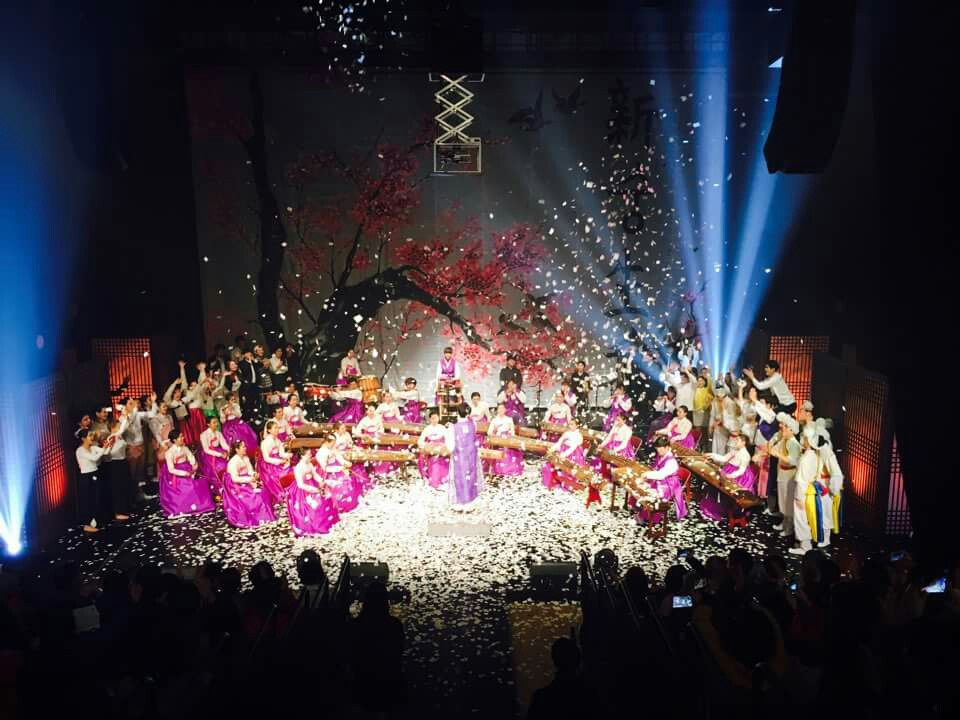
If you think about the performances and concerts of university students, generally, a graduation performance of seniors may come at first into your mind. The graduation performance or concert is a stage for seniors who finish their undergraduate studies to show their efforts and abilities. However, these performances are not all shows delivered by seniors from the College of Art; there are some concerts delivered by freshmen. One of them is a spring concert by the Department of Traditional Arts. It would be nice if you could enjoy the spring with sunny weather and performances by freshmen who are just starting their lives in university. Let’s read the review of the spring concert held on March 30th at Anseong campus.
1. Invite You to Spring Concert!
The Department of Traditional Arts at CAU is the first and only higher educational institution of Korean traditional music and dance which educates theories and practice of almost the entire field. However, it is not known well to the public for its reputation in the field. There are two main majors of the department. One is music art major and it is divided into two fields, which are traditional orchestral music and composition of traditional music. The other is traditional theatricals major. It is composed of a musical play field and a percussion instruments field. In short, the department contains almost all you know about Korean traditional music and dance. The students generally join art companies or become educators of Korean traditional arts after graduation.
The spring concert is held every March and performances of freshmen are on stage. Although the students are not well trained and educated because they are just beginning school, they prepare their performance for the concert by themselves with assistance from students of the junior and sophomore classes. The concert has two parts and thirteen performances in total.
2. The Appreciation About Students’ Performances
1) New Boating Song
The New boating Song reinterprets the original Boating Song, which is one of the Korean traditional folk songs. It adds to the rhythm and melody of the original to give the best life. The refined arrangement also adds pleasure of appreciating. It was performed at the end of the concert. Therefore, many kinds of instruments such as drums, janggu (double-headed drums with narrow waists in the middle), kkwaenggwari (small gongs), gayageum (zithers with twelve strings), geomungo (zithers with six strings), taepeyeongso (conical oboes), and so on were brought on to the stage. The audience could enjoy the harmony of various instruments. As the song was very exciting, the concert could conclude with joy.
2) Samulnori
Samulnori is a part of Korean traditional arts in which four players play four percussion instruments and turn round and round while each twirls a sangmo, which is a hat with a long cloth. The four instruments of drum, janggu, kkwaenggwari, and jing make a wonderful harmony and exciting rhythm. The students could interact with the audience because they were not just sitting and playing, but turning around and showing the twirling sangmo performance. Their stage manners were so excellent that the audience couldn’t think that it was their first time to be on the stage. They focused on and genuinely enjoyed the music.
3) Our Dream, Our Sound·Wild Chrysanthemum· Let’s Go, Butterfly, to Blue Mountain
These songs were special because they were composed by freshmen. The first song, ”Our Dream, Our Sound,” was a song about their experiences of studying and practicing to enter college from high school. Second, ”Wild Chrysanthemum” expressed their expectation of campus life. Lastly, the students were transforming their feelings which they got when they were accepted to college into ”Let’s Go, Butterfly, to Blue Mountain.” The songs out of experience were magnificent. In addition, the pansori singers made a strong impression to people.
The Attraction of Korean Traditional Arts
Every culture has its own songs and dances and they reflect an identity and characteristics of the group. Then, what is reflected from Korean traditional songs and music? Although there are diverse cultural factors, Korean tragic history may most influence them. Korea was invaded by neighboring countries many times in the past, and Korean people suffered from Japanese colonial rule for 36 years. What was worse, they have a scar from the Korean War. Of course, Korean traditional music and dance were developed through festivals such as weddings and parties of royal families. However, this is a universal factor that can be found in non-Korean culture, so it is hard to call it Korean’s own characteristic.
’Han’ is the key driver of developing Korean traditional arts. Han is a unique emotion of Koreans which means a complex emotion including a strong longing, a sense of frustration, and hatred towards the hostile opponent. Korean people have sublimated Han out of their history and life and into dance and music. For example, ”Nongak,” which is the tradition Korean music performed by farmers, was created to relieve fatigue by working with music. In addition, the people who were squeezed by corrupt officials made a mask dance called the ”Ttalchum.” They criticized these corrupt officials with humor and wit while wearing masks. Therefore, the attraction of Korean traditional art is the wisdom of Korean people who comforted themselves by sublimating pain into art.
In fact, young Korean people nowadays don’t know much about traditional music and they are not interested in it at all, although they enjoy listening to K-Pop and various pop from other countries. However, there are students who love Korean traditional music and dance so much that they major in them. At the concert, they expressed their love and passion for traditional culture even though they were not perfect or fully trained yet. Young students who were bubbling over with the joy of performing made the audience feel touched. It is anticipated to watch their graduation concert that will be held about four years from now.

